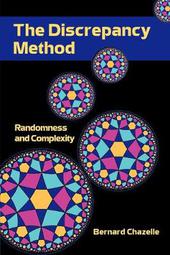
|
The Discrepancy Method: Randomness and Complexity
Paperback / softback
Main Details
| Title |
The Discrepancy Method: Randomness and Complexity
|
| Authors and Contributors |
By (author) Bernard Chazelle
|
| Physical Properties |
| Format:Paperback / softback | | Pages:494 | | Dimensions(mm): Height 229,Width 152 |
|
| Category/Genre | Mathematical theory of computation |
|---|
| ISBN/Barcode |
9780521003575
|
| Classifications | Dewey:512.7 |
|---|
| Audience | | Professional & Vocational | | Tertiary Education (US: College) | |
|---|
| Illustrations |
160 Line drawings, unspecified
|
|
Publishing Details |
| Publisher |
Cambridge University Press
|
| Imprint |
Cambridge University Press
|
| Publication Date |
14 January 2002 |
| Publication Country |
United Kingdom
|
Description
The discrepancy method is the glue that binds randomness and complexity. It is the bridge between randomized computation and discrepancy theory, the area of mathematics concerned with irregularities in distributions. The discrepancy method has played a major role in complexity theory; in particular, it has caused a mini-revolution of sorts in computational geometry. This book tells the story of the discrepancy method in a few short independent vignettes. It is a varied tale which includes such topics as communication complexity, pseudo-randomness, rapidly mixing Markov chains, points on the sphere and modular forms, derandomization, convex hulls, Voronoi diagrams, linear programming and extensions, geometric sampling, VC-dimension theory, minimum spanning trees, linear circuit complexity, and multidimensional searching. The mathematical treatment is thorough and self-contained. In particular, background material in discrepancy theory is supplied as needed. Thus the book should appeal to students and researchers in computer science, operations research, pure and applied mathematics, and engineering.
Reviews'Bernard Chazelle's book The Discrepancy Method is a technical tour de force ... this is an eminently readable book.' Prabhakar Raghavan, SIAM Review ' ... the main point is that by presenting the discrepancy method in such an impressive way as this book does, the author helps us to imagine the fantastic possibilities that randomization opens up to everybody, and he shows that current research in theoretical computer science has an astonishing impact on common fundamentals of all sciences. I believe that any reader interested in principal questions will enjoy this book.' The Computer Journal
|